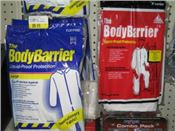Women And Personal Protective Equipment

‘Different sizes of coveralls, Martha Smith, University of Illinois
MARIA RESTREPO-TURNER
URBANA, ILLINOIS
When speaking with applicators on reasons they might not wear personal protective equipment, a theme occurs around comfort. Much of the PPE made is fitted for men and not for women which complicates matters.
According to the 2017 census, women now play a much more significant role in farming. More than half (51 percent) of all farming operations in the United States had at least one-woman operator, and 36 percent of U.S. farmers are women, according to the 2019 Agricultural Resource Management Survey (ARMS).
A woman's physique is different than a man's. Traditionally the practice with protective equipment was for a woman to purchase a size smaller for a correct fit. Since women and men are shaped differently, sizing down doesn't necessarily work. Men's shoulders are typically broader, the waist is cut higher, and the chest area requires more space. Additionally, men's garments also have a wider collar area and narrow hip. Men's hands are also typically wider, longer, and have different finger patterns than that of women. So, sizing down in PPE can lead to ill-fitting, uncomfortable, and hazardous items.
When I was in school learning to weld, I was required to get a pair of coveralls. I sized down for the coveralls, but they were still large on me. The arms were past my fingers, and the length of the legs was very long. I rolled the cuffs and pushed up the sleeves. While welding, a spark landed on the cuff of the pants and caught the pant leg on fire. Concentrating on my welds with a shield on my face, it wasn't until the teacher grabbed me that I realized I was on fire.
This could have been prevented if the ember had not landed in the cuff of the pants.
PPE that is too big can lead to tripping hazards and exposure issues with spray particles or drift entering gaps. Gloves that do not fit properly can cause dexterity issues, fatigue, and continually grabbing and adjusting the gloves could lead to dermal exposure. Respirator fit should be considered as well. Medical fit tests are required so that you may be the best protected from inhalation exposure. We have learned a lot about masks and their ability or inability to be protective through the pandemic. Masks are also not necessarily made with a women's face in mind, so be sure to look for masks that will provide protection and comfort, Then, be sure to follow with a fit test.
PPE is meant to protect the body from the pesticides being used, and with ill-fitting protective equipment, the risk of exposure is much greater. With more women involved in the agriculture industry, the availability of women's PPE has come a long way and is now more readily available. However, it is still not at the same accessibility, so manufacturers and employers need to continue to make it a priority to provide and create products that fit, making them comfortable to wear.
An employer has a responsibility to protect their employees and prevent injuries. Providing PPE that fits properly is a step in that direction. Check your measurements before just ordering a size down and remember that "One size" doesn't necessarily fit all. ∆
MARIA RESTREPO-TURNER: University of Illinois